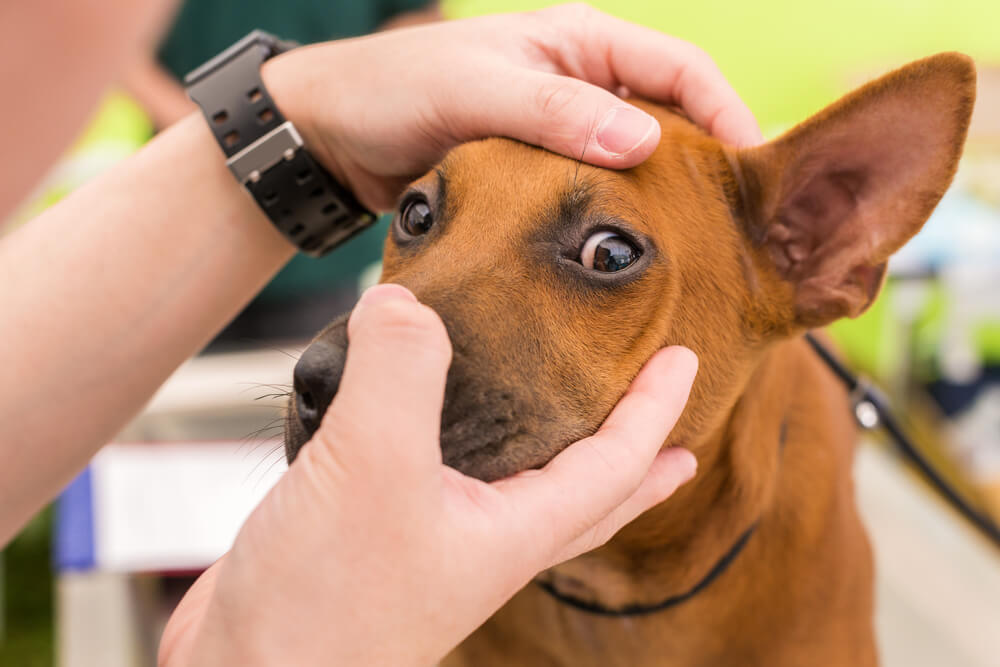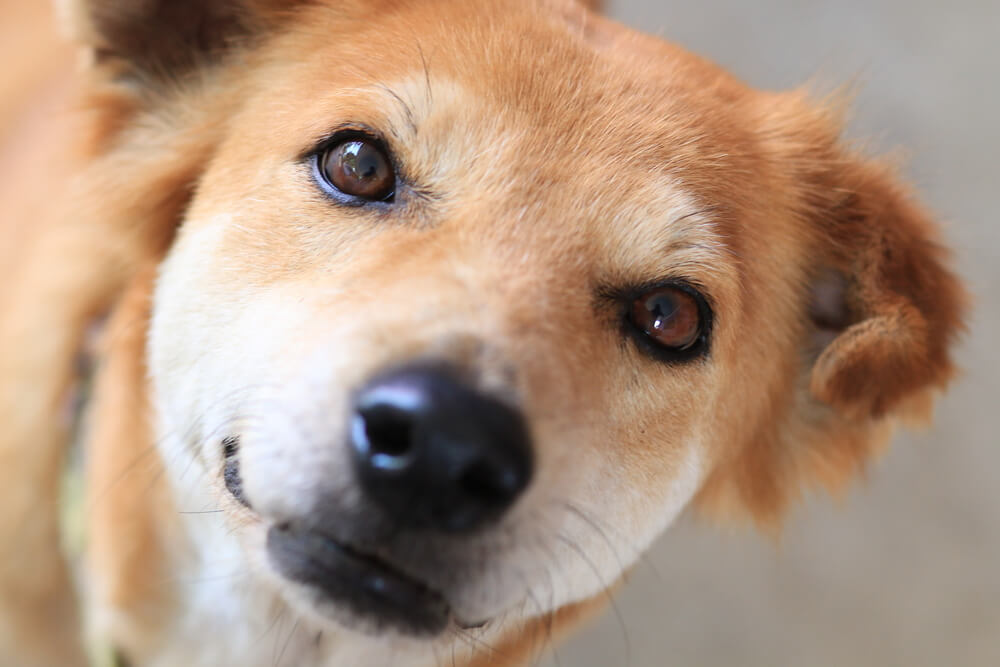Cherry Eye: What It Is & When to Seek Help for Your Dog

Table of Contents
Listen To The Article
Introduction to Cherry Eye: What It Is & When to Seek Help for Your Dog
Many dog owners have never even heard of the cherry eye, let alone know what it is and for good reason.
Although the cherry eye is one of the most common eye problems in dogs, it’s rarely talked about, and it seems like only vets talk about it.
The Cherry eye describes a situation in which the gland of the third eyelid protrudes out of the eye.
This growth can occur on one or both eyes, and often, it is a temporary situation.
However, in some cases, the growth may be permanent.
When a dog has a cherry eye, you may notice that the eye appears to be red in color.
The center of the eye may also be pink and bulging out, and the dog may not always be able to close the eye completely.
This condition can be uncomfortable for the dog, but cherry eyes can be treated easily, so it isn’t a cause for alarm.
In some cases, the condition is genetic, but cherry eyes may also be caused by an injury.
As long as the dog’s other eyes are healthy, a cherry eye is not a reason to deter from buying a dog.
Cherry eye also called medial canthus syndrome is a condition that causes a dog’s third eyelid to prolapse from its normal, hidden location.
The condition is most common in dogs with lighter-colored eyes, although it’s been reported in dogs with dark eyes as well.

What is Cherry Eye?
“Cherry eye” is the nickname for a medical condition known as a prolapsed nictitating membrane, prolapsed third eyelid, or third eyelid gland prolapse.
The third eyelid, or nictitating membrane, is this fleshy, pink part next to the eye in the eye socket.
This membrane is actually a flap of tissue that contains a gland that secretes tears and is usually not easily seen.
It should be flat and against the corner of the eye socket but in a dog with a cherry eye, it gets enlarged, flips over, and protrudes or prolapses making it abnormally visible.
All dogs have a third eyelid, also called a nictitating membrane, as well as two glands that produce tears to lubricate their eyes.
The nictitating membrane, based in the lower eyelid, is a sort of secondary shield for the eyes.
It protects dogs’ eyes from wind, dust, and other foreign objects as they play or work.
The nictitating membrane has its own dedicated tear gland.
This tear gland produces anywhere from 35 percent to 50 percent of the total moisture in a dog’s eye and is thus an essential component to overall eye health in dogs.
The Cherry eye in dogs occurs when the connective tissue that holds the gland in place is weak, faulty, or otherwise damaged.
The nictitating membrane’s tear gland comes loose and prolapses from its little pocket and out of the bottom or corner of the dog’s eye, usually closest to the nose.
This bulbous, fleshy, red protrusion of the gland from the lower eye is the primary symptom and gives the condition its colorful, fruited moniker.
If your dog has or has had, a cherry eye, you should be especially watchful.
Extended or recurring cases of cherry eye in dogs can lead to decreased tear production and other eye problems.

Signs of Cherry Eye in Dogs
- A pink bulge in the corner of the eye
- Pawing or rubbing at the eye
- Unable to close eye
A dog with a cherry eye will have a pink or red bulge that appears to be coming out of the inner corner of the eye.
This bulge won’t be bleeding and is not painful but is usually pretty obvious to an owner.
Sometimes the bulge will come and go but other times the cherry eye will be out permanently until veterinary care is received.
Aside from this obvious pink bulge in the eye though, other problems and symptoms that your veterinarian may see in a dog with a cherry eye include dry eye, corneal ulcers, irritation, and inflammation of the cornea.
These conditions then cause a dog to paw at or rub its eyes.
Dry eye develops due to a lack of tear production and since the third eyelid is responsible for making tears, if it is inflamed and not providing enough tears, the eye will not be properly lubricated.
This can then also cause irritation, inflammation, and even ulcers on the eye, especially if a dog paws at it or rubs it on the ground.
If a cherry eye is large enough, it may also make it difficult or impossible for a dog to completely close its eyes.
This can also be a contributing factor for a dry eye if the eye is kept partially open at all times.

Causes of Cherry Eye in Dogs
Cherry eyes are something a dog can be born with but more often it develops over time.
It is a congenital disorder, passed on from generation to generation.
Beyond genetic predisposition, it is still unknown what precisely causes it.
We do know that the ligaments and connective tissues that hold the tear gland of the nictitating membrane fail to keep it in place, and that cherry eye in dogs is more common in certain breeds.
The condition is most commonly seen in dogs that are 2 years of age or younger but some breeds are more likely to develop cherry eye than others.
These breeds include American Cocker Spaniels, Shih Tzus, Beagles, Lhasa Apsos, Pekingese, Maltese, Bassett Hounds, Rottweilers, Neapolitan Mastiffs, Shar-Peis, Boston Terriers, St. Bernards, and English Bulldogs

What’s the Projection for Dogs with Cherry Eyes?
Cherry eyes are not life-threatening, and the vast majority of dogs go on to live full lives with healthy eyes.
If you’re wondering if you should get a dog who has a cherry eye either from a rescue or a breeder there are a few considerations to keep in mind.
First, it’s important to remember that the cherry eye is not contagious, so it poses no risk to you or other pets.
However, surgical treatment of cherry eyes can be expensive.
Costs range from several hundred to thousands of dollars depending on the breed, your location, and your veterinarian’s rates for surgical procedures.
And, since as many as 40 percent of dogs that experience cherry eye in one eye will eventually have it in the other, you could very well end up doubling your expenses.
The good news is, the simple cherry eye surgery should solve the problem for good.
Greater than 90 percent of the surgically repositioned tear glands stay in place.
The most common complication of this surgery is the breakdown of the suture line and subsequent re-prolapse of the gland.
If the suture does fail, another surgery is likely necessary.
The condition is not an indicator of poor health or of other underlying conditions.
If your pup has a cherry eye, there’s no reason she can’t enjoy a long, happy, healthy life post-treatment.

Home Treatment For Cherry Eye in Dogs
Caught early enough, I’ve come across many online accounts of successful massage treatment of cherry eye in dogs.
Using a combination of warm, moist cloth and dog-safe eye drops, the home method of treatment involves calming the afflicted dog and gently massaging the prolapsed tear gland of the nictitating membrane until it sucks back into place.
Even when this technique is successful, though, there is no guarantee that the cherry eye is gone for good.
It may recur, and a dog who has had cherry eyes in one eye is at higher risk of having it happen in the other as well.

When To See A Vet About Cherry Eye in Dogs
The safest bet with a cherry eye in dogs is a visit to the veterinarian, who can accurately determine the specific reason for your dog’s cherry eye.
Since there is no fixed cause, an early consultation can help ensure your dog’s long-term eye health.
There are three common surgical options.
In the first case, the vet may be able to stitch the prolapsed tear gland back into place.
In other cases, a veterinary surgeon may find the connective tissue too weak to cradle the gland properly.
For situations like these, the surgeon will attempt to create a new pocket or envelope to hold it in place permanently.
The third option was, in past years, the most common, and involved the complete removal of the cherry-eyed tear gland.
Removal of the prolapsed gland is an option of absolutely last resort.
Removal of the affected tear gland will require lifelong after-treatment with artificial tears to prevent chronic dry eye and secondary problems that can occur when there’s insufficient production of lubrication for a dog’s eyes.

Long-term Effects of Cherry Eye in Dogs
Left untreated, a dog with a cherry eye is at greater risk for long-term health problems.
The longer the gland is prolapsed, the greater the risk of associated problems.
Proper blood flow to the gland is restricted.
The gland may swell the longer it is exposed.
Pawing, scratching or rubbing the affected eye may irritate it further, and create opportunities for secondary bacterial or viral infections to take hold.
In most cases, caught early enough, the cherry eye in dogs is successfully treated or managed with minimal veterinary assistance, hopefully before your dog needs surgery.

Is it Possible to Prevent Cherry Eyes?
Unfortunately, there’s no way to keep your dog from developing cherry eyes.
But there are ways to give your pup the best chance at good health.
Feed her a good diet and provide lots of exercises to maintain a healthy weight.
Schedule an appointment with your vet to make sure she stays up-to-date on all preventative care and vaccinations, and reach out to your vet if you have any concerns about your pup’s eye health.



